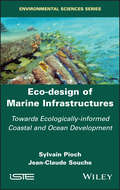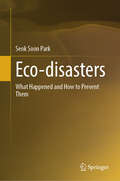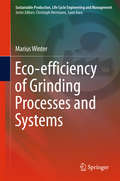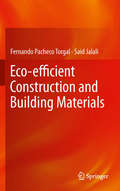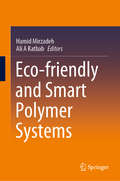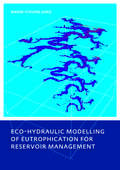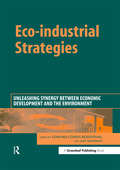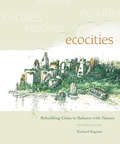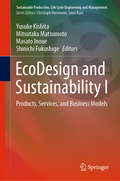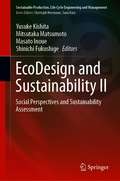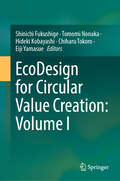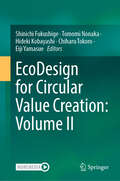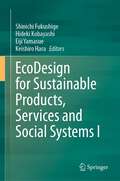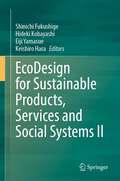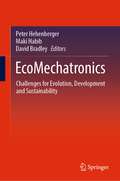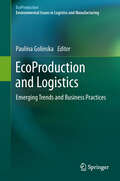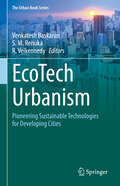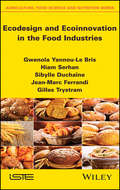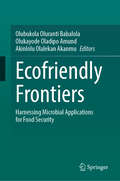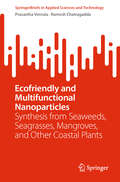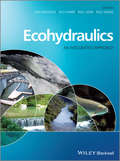- Table View
- List View
Eco-design of Marine Infrastructures: Towards Ecologically-informed Coastal and Ocean Development
by Sylvain Pioch Jean-Claude SoucheThis book offers an insight into how to create aesthetically pleasing, environmentally integrated, multi-functional developments in the ocean or on the coastline.Eco-design of Marine Infrastructures provides practical and realistic solutions for delivering projects that strive to minimize negative environmental impacts.Using case studies and examples, this book presents a toolkit of options, allowing decision makers and planners to see what is possible and to make informed choices about the risks and benefits of eco-design. It is intended for researchers, engineers, students and decision makers, or anyone who is curious to see how nature can be integrated into development.
Eco-disasters: What Happened and How to Prevent Them
by Seok Soon ParkThis book consists of 7 parts covering 42 representative environmental disasters. Part 1 introduces representative disasters in Europe, America, and Asia in the 19th century. Part 2 covers disasters related to the atmosphere. Part 3 deals with disasters caused by water and food affected by heavy metals, toxic chemicals, and pathogenic microorganisms. Part 4 examines poisoned environment caused by toxic pollutants and oil spills. Part 5 introduces nuclear power plant accidents and industrial chemical leaks. Part 6 deals with disasters occurring in the modern living environment, such as indoor air, radon, and electromagnetic radiation, and Part 7 presents cross-border disputes and planetary-wide concerns. Furthermore, this book introduces nearly all disasters that have occurred to date by adding and grouping them into similar cases alongside representative environmental disasters of each type. For example, disasters like the Exxon Valdez oil spill are detailed in parallel with similar disasters such as the Amoco Cadiz oil spill. Similarly, industrial air pollution disasters like the Meuse Valley disaster are described within the context of events like the Donora disaster. The English translation of this book, originally in Korean, was facilitated by artificial intelligence. The content was later revised by the author for accuracy.
Eco-efficiency of Grinding Processes and Systems
by Marius WinterThis research monograph aims at presenting an integrated assessment approach to describe, model, evaluate and improve the eco-efficiency of existing and new grinding processes and systems. Various combinations of grinding process parameters and system configurations can be evaluated based on the eco-efficiency. The book presents the novel concept of empirical and physical modeling of technological, economic and environmental impact indicators. This includes the integrated evaluation of different grinding process and system scenarios. The book is a valuable read for research experts and practitioners in the field of eco-efficiency of manufacturing processes but the book may also be beneficial for graduate students.
Eco-efficient Construction and Building Materials
by Fernando Pacheco Torgal Said JalaliEco-efficient Construction and Building Materials provides essential reading about materials for the construction industry in the twenty-first century. It covers the latest findings in the field, especially the toxicity aspects, embodied energy, construction and demolition wastes, the use of wastes in concrete, masonry units, materials reinforced with vegetable fibres, earth construction, the durability aspects, and also the importance of nanotechnology to the development of more environmentally-friendly materials. Based on more than nine hundred references, Eco-efficient Construction and Building Materials is of fundamental importance to academics, engineers and architects who are dedicated to the creation of a greener and more holistic construction industry.
Eco-friendly Agro-biological Techniques for Enhancing Crop Productivity
by Rakesh Singh Sengar Ashu SinghAs the world population is exploding and alongside fluctuations in climate is also prevalent, there is an increasing stress on the food requirements of the population. We have an urgent necessity to produce more food in the limited agricultural land. Further, to feed 7 billion people there is a requirement of high yielding crops, without harming environment and limiting the use of unnecessary pesticide and chemical fertilizers. Therefore it has become crucial to develop agri-bio-techniques which are environment friendly and also give high crop productivity. Many countries are evaluating the utility of biotechnology and its role in addressing problems of food security and poverty. Biotechnology is the application of scientific and engineering principles to the processing and production of materials by utilising biological agents. These agents are exploited to provide goods and services. Agricultural biotechnology encompasses a growing list of techniques that range from simple probes to determine a relevant gene from the complete genome to manipulating genes for a desired outcome. Many other popular methods used in the realm of agricultural technology are – gene integration, Marker-assisted breeding, Tissue culture, Gene profiling or association mapping, Metabolomics etc. The fundamental challenge facing the scientific community is how to devise innovative strategies that will bring all developed as well as developing countries into the “biological fold” and to do so in ways that will take full advantage of advances in the biological sciences to curb poverty, improve public health, and promote human development. This book contains information on eco-friendly techniques for high crop productivity and it is a myriad of different techniques and technology used to sustain productivity in crop plants. There are fewer books focusing on large-scale organic farming, molecular farming etc. Multidisciplinary research and literature is needed to deliver knowledge and products into the marketplace which fulfil these requirements. The present book is a collection of literature contributed by experts, scientists, professors, and researchers from around the world, it emphasizes work of concerned scientist and his choice of techniques used for enhancement of agricultural production. This book analyses the use of modern techniques to increase crop yields, production, and risk of hunger linked to socioeconomic scenarios.
Eco-friendly Polymer Nanocomposites
by Vijay Kumar Thakur Manju Kumari ThakurThis book contains precisely referenced chapters, emphasizing environment-friendly polymer nanocomposites with basic fundamentals, practicality and alternatives to traditional nanocomposites through detailed reviews of different environmental friendly materials procured from different resources, their synthesis and applications using alternative green approaches. The book aims at explaining basics of eco-friendly polymer nanocomposites from different natural resources and their chemistry along with practical applications which present a future direction in the biomedical, pharmaceutical and automotive industry. The book attempts to present emerging economic and environmentally friendly polymer nanocomposites that are free from side effects studied in the traditional nanocomposites. This book is the outcome of contributions by many experts in the field from different disciplines, with various backgrounds and expertises. This book will appeal to researchers as well as students from different disciplines. The content includes industrial applications and will fill the gap between the research works in laboratory to practical applications in related industries.
Eco-friendly Polymer Nanocomposites
by Vijay Kumar Thakur Manju Kumari ThakurThis book contains precisely referenced chapters, emphasizing environment-friendly polymer nanocomposites with basic fundamentals, practicality and alternatives to traditional nanocomposites through detailed reviews of different environmental friendly materials procured from different resources, their synthesis and applications using alternative green approaches. The book aims at explaining basics of eco-friendly polymer nanocomposites from different natural resources and their chemistry along with practical applications which present a future direction in the biomedical, pharmaceutical and automotive industry. The book attempts to present emerging economic and environmentally friendly polymer nanocomposites that are free from side effects studied in the traditional nanocomposites. This book is the outcome of contributions by many experts in the field from different disciplines, with various backgrounds and expertises. This book will appeal to researchers as well as students from different disciplines. The content includes industrial applications and will fill the gap between the research works in laboratory to practical applications in related industries.
Eco-friendly and Smart Polymer Systems
by Hamid Mirzadeh Ali A KatbabThis proceedings book presents the main findings of the 13th International Seminar on Polymer Science and Technology ( ISPST 2018), which was held at Amirkabir University of Technology, Tehran, on November 10–22, 2018. This forum was the culmination of more than three decades of academic and industrial activities of Iranian scholars and professionals, and the participation of many notable international scientists, in covering various important polymer-related subjects of concern to Iran and the world at large, including polymer synthesis, processing and properties, as well as issues concerning polymer degradation, stability, and environmental aspects. For the past half a century, the growing concern for advancing human health, quality of life, and – especially in the last few decades – avoiding and combating environmental pollution have shaped and driven scientific activities geared toward the creation of smart materials that are compatible with the human body, and have prompted scientists and technologists to pursue research using natural and sustainable sources. This book highlights efforts to responsibly address the problems caused by, and which can potentially be solved by, polymers and plastics.
Eco-hydraulic Modelling of Eutrophication for Reservoir Management
by Nahm-chung JungThis study presents an systematic approach to water quality assessment, hybrid modelling and decision support for eutrophication management in deep reservoirs. It is found that during the summer monsoon the catchment runoff into the Yongdam reservoir induces a transfer of pollutants from a middle stratified layer to the surface layer. Although the
Eco-industrial Strategies: Unleashing Synergy between Economic Development and the Environment
by Judy MusnikowEco-industrial development is born from the realisation that the places where we work waste too much and unnecessarily pollute the land, air and water. This book explores the key issues involved in developing eco-parks and identifies the stakeholders and their roles in such projects.
EcoCities
by Richard RegisterMost of the world's population now lives in cities. So if we are to address the problems of environmental deterioration and peak oil adequately, the city has to be a major focus of attention.Ecocities is about re-building cities and towns based on ecological principles for the long term sustainability, cultural vitality and health of the Earth's biosphere. Unique in the literature is the book's insight that the form of the city really matters - and that it is within our ability to change it, and crucial that we do. Further, that the ecocity within its bioregion is comprehensible and do-able, and can produce a healthy and potentially happy future.Ecocities describes the place of the city in evolution, nature and history. It pays special attention to the key question of accessibility and transportation, and outlines design principles for the ecocity. The reader is encouraged to plunge in to its economics and politics: the kinds of businesses, planning and leadership required. The book then outlines the tools by which a gradual transition to the ecocity could be accomplished. Throughout, this new edition is generously illustrated with the author's own inspired visions of what such rebuilt cities might actually look like.Richard Register is one of the world's great theorists and authors in ecological city design and planning. The founder of Urban Ecology and Ecocity Builders, he convened the first International Ecocity Conference in 1990, lectures around the world, and has authored two previous books, as well as an earlier edition of Ecocities.
EcoDesign and Sustainability I: Products, Services, and Business Models (Sustainable Production, Life Cycle Engineering and Management)
by Mitsutaka Matsumoto Shinichi Fukushige Yusuke Kishita Masato InoueThis book highlights cutting-edge ecodesign research, covering product and service design, smart manufacturing, and social perspectives in ecodesign. Featuring selected papers presented at EcoDesign 2019: 11th International Symposium on Environmentally Conscious Design and Inverse Manufacturing, it also includes diverse, interdisciplinary approaches to foster ecodesign research and activities. In the context of Sustainable Development Goals (SDGs), it addresses the need for the manufacturing industry to design innovations for sustainable value creation, taking into account technological developments, legislation, and consumer lifestyles. Further, the book discusses the concept of circular economy, which originated in Europe and aims to increase resource efficiency by shifting away from the linear economy. Focusing on product life cycle design and management, smart manufacturing, circular economy, and business strategies, and providing useful approaches and solutions to these emerging concepts, this book is intended for both researchers and practitioners working in the broad field of ecodesign and sustainability.
EcoDesign and Sustainability II: Social Perspectives and Sustainability Assessment (Sustainable Production, Life Cycle Engineering and Management)
by Mitsutaka Matsumoto Shinichi Fukushige Yusuke Kishita Masato InoueThis book highlights cutting-edge ecodesign research, covering product and service design, smart manufacturing, and social perspectives in ecodesign. Featuring selected papers presented at EcoDesign 2019: 11th International Symposium on Environmentally Conscious Design and Inverse Manufacturing, it also includes diverse, interdisciplinary approaches to foster ecodesign research and activities. In the context of Sustainable Development Goals (SDGs), it addresses the need for the manufacturing industry to design innovations for sustainable value creation, taking into account technological developments, legislation, and consumer lifestyles. Further, the book discusses the concept of circular economy, which originated in Europe and aims to increase resource efficiency by shifting away from the linear economy.Focusing on product life cycle design and management, smart manufacturing, circular economy, and business strategies, and providing useful approaches and solutions to these emerging concepts, this book is intended for both researchers and practitioners working in the broad field of ecodesign and sustainability.
EcoDesign for Circular Value Creation: Volume I
by Shinichi Fukushige Tomomi Nonaka Hideki Kobayashi Eiji Yamasue Chiharu TokoroThis 2-volume book sheds new light on the forefront of ecodesign research, encompassing product and service design, smart manufacturing, and social perspectives. Featuring selected papers from EcoDesign 2023: 13th International Symposium on Environmentally Conscious Design and Inverse Manufacturing, it offers interdisciplinary approaches to foster sustainable innovations. Within the framework of the Sustainable Development Goals (SDGs), it underscores the necessity for the manufacturing sector to innovate for sustainable value creation, taking into account technological advancements, regulatory requirements, and consumer behavior. Additionally, it explores the concept of the circular economy, which originated in Europe and seeks to enhance resource efficiency by transitioning from a linear to a circular economic model. This book aims to unite professionals across the globe who are dedicated to advancing the field of ecodesign, and facilitating the exchange of knowledge across various disciplines and communities. The first volume highlights the product life cycle design and management, sustainability assessment for ecoDesign, and circular economy. Readers will delve into the environmentally conscious design of products and services, life cycle management, sustainable manufacturing, EoL management and process technologies, green supply chain management, life cycle evaluation, and sustainability indices. Contributions from renowned scholars provide critical insights into ecodesign regulations compliance processes like EPD certifications; consumer behavior towards eco-labels; innovative business models for sustainability; participatory approaches for ESG initiatives; digital twins for real-time life cycle assessment; AI techniques supporting wastewater treatment; among others.
EcoDesign for Circular Value Creation: Volume II
by Shinichi Fukushige Tomomi Nonaka Hideki Kobayashi Eiji Yamasue Chiharu TokoroThis 2-volume book highlights cutting-edge ecodesign research, encompassing product and service design, smart manufacturing, and social perspectives. Featuring selected papers from EcoDesign 2023: 13th International Symposium on Environmentally Conscious Design and Inverse Manufacturing, it offers interdisciplinary approaches to foster sustainable innovations. Within the framework of the Sustainable Development Goals (SDGs), it underscores the necessity for the manufacturing sector to innovate for sustainable value creation, taking into account technological advancements, regulatory requirements, and consumer behavior. Additionally, it explores the concept of the circular economy, which originated in Europe and seeks to enhance resource efficiency by transitioning from a linear to a circular economic model. This book aims to unite professionals across the globe who are dedicated to advancing the field of ecodesign, and facilitating the exchange of knowledge across various disciplines and communities. The second volume highlights sustainable technology, social perspectives in ecodesign, and business strategy. The chapters cover digital and AI technologies for sustainability, sustainable social infrastructure, smart manufacturing, sustainable consumption and production, policy, legislation and social activities, finance and investment for sustainability, green business, and engineering economics. Readers will discover diverse perspectives from expert contributors who delve into critical issues like climate change education in primary schools in Vietnam; food security in Japan; repurposing lithium-ion batteries; carbon neutrality through sensor-based smart city services; life cycle assessments of automotive parts; human health risks from chemicals in export products; and developing high-resolution spatial global biodiversity damage factors. This collection invites readers to think through critical questions about resource efficiency and the shift from a linear to a circular economy. Researchers in the fields of sustainable design, environmental engineering, policy-making, and business strategy will find this book invaluable.
EcoDesign for Sustainable Products, Services and Social Systems I
by Shinichi Fukushige Hideki Kobayashi Eiji Yamasue Keishiro HaraThis 2-volume book highlights cutting-edge ecodesign research and covers broad areas ranging from individual product and service design to social system design. It includes business and policy design, circular production, life cycle design and management, digitalization for sustainable manufacturing, user behavior and health, ecodesign of social infrastructure, sustainability education, sustainability indicators, and energy system design. Featuring selected papers presented at EcoDesign 2021: 12th International Symposium on Environmentally Conscious Design and Inverse Manufacturing, it also includes diverse, interdisciplinary approaches to foster ecodesign research and activities. In the context of Sustainable Development Goals (SDGs), in particular SDG 12 (Responsible Consumption and Production), it addresses design innovations for sustainable value creation, considering technological developments, legislation, and consumer lifestyles. Further, the book discusses the concept of circular economy, which aims to develop circular business models for resource efficient society by taking advantage of digital technologies including artificial intelligence, internet of things, digital twin, data analysis and simulation. Written by experts from academia and industry, Volume 1 highlights sustainable design such as product and process design, collaborative design, sustainable innovation, digital technologies, design methodology for sustainability, and energy system design. The methods, tools, and practices described are useful for readers to facilitate value creation for sustainability.
EcoDesign for Sustainable Products, Services and Social Systems II
by Shinichi Fukushige Hideki Kobayashi Eiji Yamasue Keishiro HaraThis 2-volume book highlights cutting-edge ecodesign research and covers broad areas ranging from individual product and service design to social system design. It includes business and policy design, circular production, life cycle design and management, digitalization for sustainable manufacturing, user behavior and health, ecodesign of social infrastructure, sustainability education, sustainability indicators, and energy system design. Featuring selected papers presented at EcoDesign 2021: 12th International Symposium on Environmentally Conscious Design and Inverse Manufacturing, it also includes diverse, interdisciplinary approaches to foster ecodesign research and activities. In the context of Sustainable Development Goals (SDGs), in particular SDG 12 (Responsible Consumption and Production), it addresses design innovations for sustainable value creation, considering technological developments, legislation, and consumer lifestyles. Further, the book discusses the conceptof circular economy, which aims to develop circular business models for resource efficient society by taking advantage of digital technologies including artificial intelligence, internet of things, digital twin, data analysis and simulation. Written by experts from academia and industry, Volume 2 focuses on the sustainability assessment of product lifecycle, waste management, material circularity and energy efficiency, food and agriculture, user behavior and health, and transportation. The methods, tools, and practices described are useful for readers to facilitate value creation for sustainability.
EcoMechatronics: Challenges for Evolution, Development and Sustainability
by David Bradley Peter Hehenberger Maki HabibThis book showcases how EcoMechatronics can increase sustainability within engineering and manufacturing. It brings together material from experts in core mechatronics technologies, discussing the challenges related to moving towards more environmentally friendly methods, and presenting numerous case studies and examples of EcoMechatronics oriented applications. The book begins with an introduction to EcoMechatronics in the context of sustainability, before covering core conceptual, technical and design issues associated with EcoMechatronics. It then offers a series of case studies and examples of EcoMechatronics oriented applications and finally, a consideration of the educational issues associated with moving to a new generation of environmentally oriented mechatronic engineers. EcoMechatronics will be of interest to practicing engineers, researchers, system developers. and graduate students in the field of mechatronics and environmental engineering.
EcoProduction and Logistics: Emerging Trends and Business Practices
by Paulina GolinskaEnvironmental awareness is driven mainly by the scarcity of natural resources and by more strict legal regulations. The modern enterprise policy should look at the relations between economic actions and ecological consequences. Ecoproduction is a new business approach which focuses on the most efficient and productive use of raw materials and natural resources in order to minimize footprints on the natural environment. This book aims to provide the state- of- the- art as well as new ideas of the environmental conscious operations management. The contributors present in the individual chapters problems related to: eco-friendly production technologies; recycling and waste reduction. Scope of topics discussed in this book covers also pollution prevention, energy efficiency. The authors describe problems of information management in complex systems
EcoTech Urbanism: Pioneering Sustainable Technologies for Developing Cities (The Urban Book Series)
by Venkatesh Baskaran S. M. Renuka R. VelkennedyIn a world experiencing unprecedented urbanization and drastic climate change, there is immense demand for creative solutions to the environmental, social, and economic obstacles faced by burgeoning cities in the developing world. This book delves into the potential of innovative urban initiatives to address the challenges of urbanization in countries with limited resources, thereby contributing to sustainable and inclusive urban development. It explores how cutting-edge technologies can provide efficient functionality for urban residents through information and communications shared among stakeholders. The primary aim is to enhance the efficiency of urban operations, foster economic development, and improve the well-being of residents by leveraging intelligent technologies and analyzing data. Government and policy are recognized as fundamental drivers of urban development, and the book sheds light on initiatives supporting cities that are not only technologically advanced but also sustainable, inclusive, and equitable. Contributions provide insight into technological aspects of urbanism, including the Internet of Things (IoT), sensors, data analytics, and essential infrastructure for sustainable city development. They also emphasize the importance of community engagement and inclusivity, stressing that urban initiatives should be designed for the benefit of all citizens, leaving no one behind. EcoTech Urbanism makes a compelling case for the imperative of sustainability in the future of urban areas, underscoring the critical role of technology in achieving this goal. The book offers a holistic perspective on the integration of eco-friendly technologies, fostering a balance between urban development and environmental conservation, ultimately paving the way for a future where cities thrive sustainably and inclusively.
Ecodesign and Ecoinnovation in the Food Industries
by Gwenola Yannou-Le Bris Hiam Serhan Sibylle Duchaine Jean-Marc Ferrandi Gilles TrystramInnovations of agri-food systems during the last 50 years have been guided by a globalized agro-industrial paradigm, which has contributed to climate change, degradation of natural resources, soil depletion, social inequalities, loss of biodiversity and various food-related health problems. Despite the increasing emphasis of food policies and research to address these issues with ecologically sustainable innovations, there are still no studies that explain how to utilize and integrate ecodesign practices in food products development in a world of finite resources. This book explains how to employ ecodesign in business models to address the economic, social, environmental, and nutritional problems that face the world's food systems. The lessons of the ÉcoTrophélia project ? a unique program implemented by a group of European agricultural higher education institutions to involve students in designing and developing food ecoinnovation projects ? are explored. Through an analysis of these projects, the authors describe the tools, methods and standards that were developed to institute ecodesign into the business models of 11 ecologically-friendly food products. This book provides operational good practices that can be implemented in educational programs and agri-food industries, to orient learning and practices towards greater sustainability.
Ecofriendly Frontiers: Harnessing Microbial Applications for Food Security
by Olubukola Oluranti Babalola Olukayode Oladipo Amund Akinlolu Olalekan AkanmuThe book "Ecofriendly Frontiers: Harnessing Microbial Applications for Food Security" explores the untapped potential of microbes in agriculture. This book explores the fascinating world of beneficial microorganisms, unveiling their hidden abilities to enhance crop yield, reduce waste, and fortify our food supply. It makes a compelling call to action. It empowers readers to participate in the global movement towards sustainable food practices. Every chapter offers actionable steps, empowering individuals and communities to make a difference. The book is packed with practical applications, and it bridges the gap between scientific research and actionable solutions. Readers would gain valuable insight that can be applied locally and globally, fostering a sustainable food future for all. Furthermore, the leading experts in microbiology, agriculture, and environmental science participated in this book; they deliver information backed by cutting-edge research. Readers can trust the credibility of the content, gaining insights that are both reliable and forward-thinking. Lastly, this book caters to a broad audience. The complex scientific concepts are broken down into digestible, engaging narratives, making them accessible and inspiring for readers of all backgrounds.
Ecofriendly and Multifunctional Nanoparticles: Synthesis from Seaweeds, Seagrasses, Mangroves, and Other Coastal Plants (SpringerBriefs in Applied Sciences and Technology)
by Prasastha Ram Vemula Ramesh ChatragaddaThis book highlights a comprehensive analysis of marine flora-derived nanoparticles (MFNPs), encompassing synthesis, characterization, physiological properties, and regulatory factors. It delves into the benefits of conjugation, mechanisms of action, and limitations, highlighting the challenges and opportunities in the field. The book identifies research gaps and outlines future directions, providing valuable insights for researchers and professionals working with MFNPs. The book covers a range of marine flora, including seaweeds, seagrasses, mangroves, and other coastal plants. By shedding light on the potential applications of MFNPs, this book serves as a valuable resource for those in the field. It fosters further research and innovation, ultimately contributing to the advancement of MFNP-based technologies and their applications in various industries.
Ecohealth Research in Practice
by Dominique F. CharronThis book is about doing innovative research to achieve sustainable and equitable change in people's health and well-being through improved interactions with the environment. It presents experiences from the field of ecosystem approaches to health (or ecohealth research) and some insights and lessons learned. It builds on previous literature, notably Forget (1997), Forget and Lebel (2001), Lebel (2003), and Waltner-Toews et al. (2008). Through case-studies and other contributions by researchers supported by Canada's International Development Research Centre (IDRC), the book presents evidence of real changes in conditions of people, their health, and the ecosystems that support them. These changes were derived from applications of an ecosystem approach to health in developing regions of the world. The book also illustrates the resulting body of applied, participatory, and action research that improved health and environmental management in developing countries and, in many cases, influenced policies and practices.
Ecohydraulics
by Paul Kemp Paul J. Wood Atle Harby Ian MaddockEcohydraulics: An Integrated Approachprovides a research level text which highlights recent developments of this emerging and expanding field. With a focus on interdisciplinary research the text examines:-the evolution and scope of ecohydraulicsinteractions between hydraulics, hydrology, fluvial geomorphology and aquatic ecologythe application of habitat modelling in ecohydraulic studiesstate of the art methodological developments and approachesdetailed case studies including fish passage design and the management of environmental flow regimesresearch needs and the future of ecohydraulics researchThe contributions offer broad geographic coverage to encapsulate the wide range of approaches, case studies and methods used to conduct ecohydraulics research. The book considers a range of spatial and temporal scales of relevance and aquatic organisms ranging from algae and macrophytes to macroinvertebrates and fish. River management and restoration are also considered in detail, making this volume of direct relevance to those concerned with cutting edge research and its application for water resource management.Aimed at academics and postgraduate researchers in departments of physical geography, earth sciences, environmental science, environmental management, civil engineering, biology, zoology, botany and ecology; Ecohydraulics: An Integrated Approach will be of direct relevance to academics, researchers and professionals working in environmental research organisations, national agencies and consultancies.
